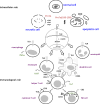Prothymosin alpha: a ubiquitous polypeptide with potential use in cancer diagnosis and therapy
- PMID: 22366887
- PMCID: PMC11029552
- DOI: 10.1007/s00262-012-1222-8
Prothymosin alpha: a ubiquitous polypeptide with potential use in cancer diagnosis and therapy
Abstract
The thymus is a central lymphoid organ with crucial role in generating T cells and maintaining homeostasis of the immune system. More than 30 peptides, initially referred to as "thymic hormones," are produced by this gland. Although the majority of them have not been proven to be thymus-specific, thymic peptides comprise an effective group of regulators, mediating important immune functions. Thymosin fraction five (TFV) was the first thymic extract shown to stimulate lymphocyte proliferation and differentiation. Subsequent fractionation of TFV led to the isolation and characterization of a series of immunoactive peptides/polypeptides, members of the thymosin family. Extensive research on prothymosin α (proTα) and thymosin α1 (Tα1) showed that they are of clinical significance and potential medical use. They may serve as molecular markers for cancer prognosis and/or as therapeutic agents for treating immunodeficiencies, autoimmune diseases and malignancies. Although the molecular mechanisms underlying their effect are yet not fully elucidated, proTα and Tα1 could be considered as candidates for cancer immunotherapy. In this review, we will focus in principle on the eventual clinical utility of proTα, both as a tumor biomarker and in triggering anticancer immune responses. Considering the experience acquired via the use of Tα1 to treat cancer patients, we will also discuss potential approaches for the future introduction of proTα into the clinical setting.
Conflict of interest statement
The authors declare that they have no conflict of interest.
Figures

 secretion of cytokine;
secretion of cytokine;  stimulation of proliferation
stimulation of proliferationSimilar articles
-
Prothymosin Alpha and Immune Responses: Are We Close to Potential Clinical Applications?Vitam Horm. 2016;102:179-207. doi: 10.1016/bs.vh.2016.04.008. Epub 2016 May 27. Vitam Horm. 2016. PMID: 27450735 Free PMC article. Review.
-
Prothymosin Alpha: An Alarmin and More..Curr Med Chem. 2017;24(17):1747-1760. doi: 10.2174/0929867324666170518110033. Curr Med Chem. 2017. PMID: 28521686 Review.
-
Prothymosin α and a prothymosin α-derived peptide enhance T(H)1-type immune responses against defined HER-2/neu epitopes.BMC Immunol. 2013 Sep 22;14:43. doi: 10.1186/1471-2172-14-43. BMC Immunol. 2013. PMID: 24053720 Free PMC article.
-
[Prothymosin alpha and tumor: current status and perspective].Ai Zheng. 2007 Mar;26(3):333-6. Ai Zheng. 2007. PMID: 17355803 Review. Chinese.
-
The immunologically active site of prothymosin alpha is located at the carboxy-terminus of the polypeptide. Evaluation of its in vitro effects in cancer patients.Cancer Immunol Immunother. 2006 Oct;55(10):1247-57. doi: 10.1007/s00262-005-0108-4. Epub 2006 Feb 2. Cancer Immunol Immunother. 2006. PMID: 16453152 Free PMC article.
Cited by
-
Quantitative Proteomics Identifies Activation of Hallmark Pathways of Cancer in Patient Melanoma.J Proteomics Bioinform. 2013 Mar 1;6(3):43-50. doi: 10.4172/jpb.1000260. J Proteomics Bioinform. 2013. PMID: 23976835 Free PMC article.
-
Role of EBNA-3 Family Proteins in EBV Associated B-cell Lymphomagenesis.Front Microbiol. 2016 Apr 7;7:457. doi: 10.3389/fmicb.2016.00457. eCollection 2016. Front Microbiol. 2016. PMID: 27092119 Free PMC article. Review.
-
Prothymosin Alpha and Immune Responses: Are We Close to Potential Clinical Applications?Vitam Horm. 2016;102:179-207. doi: 10.1016/bs.vh.2016.04.008. Epub 2016 May 27. Vitam Horm. 2016. PMID: 27450735 Free PMC article. Review.
-
Pancancer landscape analysis of the thymosin family identified TMSB10 as a potential prognostic biomarker and immunotherapy target in glioma.Cancer Cell Int. 2022 Sep 26;22(1):294. doi: 10.1186/s12935-022-02698-5. Cancer Cell Int. 2022. PMID: 36163046 Free PMC article.
-
Prothymosin α variants isolated from CD8+ T cells and cervicovaginal fluid suppress HIV-1 replication through type I interferon induction.J Infect Dis. 2015 May 1;211(9):1467-75. doi: 10.1093/infdis/jiu643. Epub 2014 Nov 17. J Infect Dis. 2015. PMID: 25404520 Free PMC article.
References
Publication types
MeSH terms
Substances
LinkOut - more resources
Full Text Sources
Other Literature Sources

